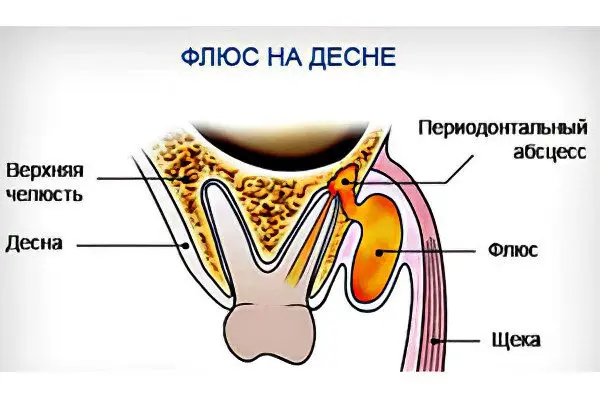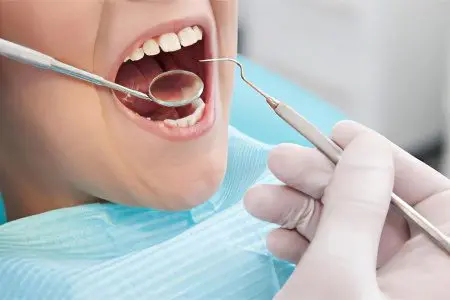Contents

Odontogenic periostitis, or gum flux, is a serious dental pathology. Periostitis can occur at any age. Inattention to the condition of one’s teeth, as well as unwillingness to visit a dentist for timely treatment of caries, can cause an acute complicated form of this disease – flux. In modern medicine, this disease is called periostitis.
Through the carious cavity, the infection reaches the pulp, causing inflammation. Pulpitis is painful, but when the pulp dies, the pain subsides at the same time. However, this stage is fraught with a special danger: the inflammatory process goes into a latent form, thereby delaying the start of treatment. The infection gradually covers the root of the tooth, and pus accumulates at its base. Sooner or later, the focus with bacteria is activated, inflaming the jaw bone.
The acute form of the flux is characterized by purulent formations that come out and begin to accumulate under the periosteum.
Flux symptoms

Flux is diagnosed primarily with toothache. It intensifies when you chew or press on the aching tooth. There is also swelling of the mucous membrane and tissues surrounding the tooth and the appearance of a bump filled with pus on the gum.
If the diseased tooth is in the upper jaw, the lips and cheeks swell, swelling of the eyelids and infraorbital region occur. If on the bottom, then swelling of the cheeks, the chin area may appear, the lymph nodes under the jaw may increase and hurt.
The body reacts to the infection with an increase in temperature (up to 38 ° C), a general malaise. Moreover, in adults, the general symptoms are more pronounced than in children and the elderly.
In the acute form of the flux, there is a strong swelling of the gums, which can spread to the upper lip and nasolabial fold. After some time, pus spills between the muscles, capturing the soft tissues of the face and neck. Such an advanced stage is fatal.
The chronic form of the flux proceeds slowly. It is characterized by the fact that the jawbone under the affected tooth thickens. Despite the slowness, the inflammatory process continues to develop.
Causes of flux on the gum

The cause of the flux can be teeth affected by caries, mechanical damage to the oral mucosa or skin, inflammation of the gingival pocket (between the tooth and gum), microbes introduced into the tissue during anesthesia with a syringe, tonsillitis, boils.
One way or another, the occurrence of flux is associated with infection. Delaying the start of treatment, the patient creates in his oral cavity a favorable environment for the reproduction of bacteria that corrode the pulp and reach the periosteum. There is another option, when the patient stops treatment after the first session at the dentist. A temporary filling with arsenic, if not removed in time, destroys the pulp and also contributes to the development of the flux.
If you do not seek medical help at the first symptoms of periostitis, pathogenic bacteria destroy the dental pulp and penetrate into the periosteum. If the tooth treatment is not completed, this circumstance can also cause gum flux. For example, if a temporary filling with arsenic is not removed in time, the pulp tissue is destroyed and periostitis occurs.
With a flux that has arisen due to caries, inflammation occurs due to pathogenic bacteria that have penetrated the tooth pulp. The initial stage of this process is accompanied by severe pain. After the death of the pulp, the pain subsides, however, this does not indicate recovery, but the beginning of a latent inflammatory process. This latent form of periostitis is difficult to diagnose and start treatment on time. Purulent masses accumulate on the root of a tooth affected by an infection.
Soon, the focus of infection is activated, the periosteum, the bones of the skull become inflamed. Complicated periostitis in severe form is accompanied by an accumulation of pus under the periosteum.
Purulent flux on the gum

More than half of the dentist’s patients suffer from odontogenic periostitis, or purulent flux on the gums. In the first day of its development, the flux is a small abscess. After 36-48 hours, it repeatedly increases in size. Visually, a purulent formation looks like a bump located on the gum.
The pain that arose during the development of purulent inflammation radiates to the eyes, ears, temporal, frontal and parietal parts of the head. The patient has chills, fever, dizziness.
Odontogenic periostitis is an acute inflammatory process in the tissues of the jaw or periosteum of the alveolar process. Most often, it occurs on the lower gum – where the wisdom teeth and the first molars are located, less often – at the location of the canines and the first incisors.
With the introduction of an infectious factor, the flux is localized on the upper gum – at the location of the wisdom teeth, the first and small molars.
In the surgical treatment of pathology, the surgeon performs an incision in the abscess, inserts drainage into it to remove pus.
Types of microorganisms that exist in the microflora of the purulent contents of the flux:
Staphylococci,
streptococcus,
Gram-positive bacteria
Gram-negative bacteria.
Treatment of purulent periostitis is carried out under the guidance of a dentist.
Effects of flux on the gum

The course of periostitis can be fatal due to the appearance of phlegmon. This complication proceeds similarly to an abscess, however, unlike it, pus is not limited to a capsule. Purulent masses spread through the fatty tissue of the maxillofacial region.
Forms and localization of phlegmon:
The deep form is localized in the intermuscular tissue;
The superficial form is localized in the subcutaneous tissue.
Without treatment, the disease progresses, affecting healthy tissues, accompanied by increasing pain.
Signs of phlegmon with periostitis:
Restriction of jaw mobility;
Deterioration of speech and free breathing;
The appearance of pain while eating;
Violation of the symmetry of the face;
Deterioration of the general condition;
Severe hyperthermia.
Surgical treatment of phlegmon with periostitis is the only possible way out of this situation. It is carried out in the surgical department of a dental hospital. With sepsis, which began due to flux, the disease can be fatal.
Diagnostics

The dentist makes the initial diagnosis on the basis of a visual examination and analysis of symptoms, and clarifies it with the help of radiography. Laboratory tests will help to clarify the degree and form of the purulent process.
Diagnostic methods:
The easiest way to diagnose flux is to lightly tap on the tooth. The method can be effective if the patient has not previously taken analgesics that reduce sensitivity to pain.
To identify external signs, the doctor conducts a thorough examination of the oral cavity.
The dentist determines the sensitivity of the dental nerve by influencing it with heat and cold.
To clarify the diagnosis, the doctor can stimulate the dental nerve with a light discharge of electric current.
X-ray of the tissues of the tooth and gums is the most accurate way to diagnose periostitis, it allows you to clarify the size of the abscess and its exact location.
Flux treatment

Treatment of flux (periostitis) depends on the condition of the tooth and the general condition of the patient. The elimination of the purulent focus is carried out by opening the abscess. Pus comes out, but for a complete outflow in the incision, as a rule, drainage is left in the form of a rubber tube. The procedure is performed under anesthesia. A gum incision and extraction of a tooth (or tooth root) can be done at the same time.
If necessary, the dentist can prescribe anti-inflammatory and antibacterial agents, as well as a course of physiotherapy procedures. These measures will help relieve inflammation, fever, and pain.
Treatment with antibiotics is possible only under the supervision of a doctor and in clearly measured doses.
It is worth remembering some caveats associated with the treatment of flux.
Do not apply a warm compress to the sore spot! In warm temperatures, bacteria will multiply even faster.
Avoid taking antibiotics before consulting a dentist.
Do not take painkillers 2 hours before the visit to the specialist. You may have to endure pain during this time, but the doctor will be able to make a diagnosis easier and more accurately.
Avoid aspirin after opening the gums, as it will increase the risk of bleeding.
If 10 hours after the elimination of the purulent focus from the opened gum, the pain does not subside, consult a doctor immediately.
What to do if the gum burst on the gum?

Some dental patients suffering from inflammation of the tissues of the oral cavity are faced with the fact that the flux on the gum spontaneously bursts. After the opening of the flux and the release of pus, the pain and other symptoms of periostitis subside, patients feel relieved. Often they believe that the pathology has resolved spontaneously, and do not go to the dentist.
This tactic is completely wrong and can cause serious complications. The pathogenic microflora of the purulent mass remains in the oral cavity and after some time causes a recurrence of periostitis. In case of spontaneous opening of an abscess on the gum, you should definitely consult a dentist for the treatment of periostitis, a dangerous disease with severe complications.
Flux Prevention

Prevention of flux (periostitis) includes preventive measures against caries, since, in essence, flux is a consequence of neglected caries: bacteria in the mouth first destroy the tooth, and then get to the periosteal tissues. To prevent this, you should brush your teeth at least twice a day. The brush should be gentle and soft, and the toothpaste should contain fluoride. After each meal, rinsing the mouth is recommended.
Do not forget to remove tartar in a timely manner: a lot of harmful bacteria accumulate on it, contributing to the development of caries.
An important preventive measure is regular visits to the dentist. They must be done at least twice a year. Diseases of the teeth and gums will be easier to eliminate in the initial stages.
For the prevention of flux, it is recommended to eat more vegetables and fruits, especially apples and carrots. You can drink freshly squeezed juices or eat these products whole. Chewing hard fruits and vegetables will help strengthen your gums and teeth.
Author of the article: Muravitsky Boris Viktorovich, dentist, specially for the site ayzdorov.ru









